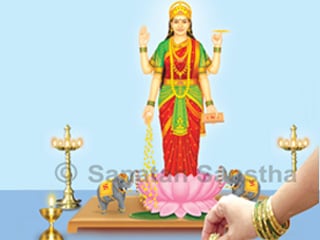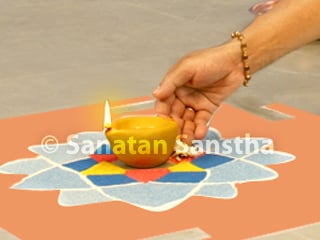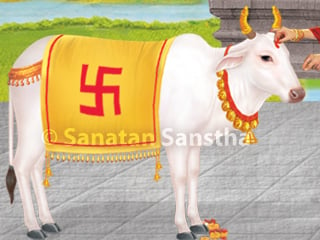Contents
- 1. Importance of Amavasya during Dipavali
- 2. Ritualistic worship of Shri Lakshmi
- 3. Elimination of Alakshmi
1. Importance of Amavasya during Dipavali
Normally Amavasya is considered inauspicious, but the Amavasya that comes in the Dipavali period is as benevolent and prosperity-bestowing as Kojagiri Pournima. During Dipavali the worship of Sri Mahalakshmi has been recommended. On Dipavali Amavasya Shri Lakshmi arrives in the house of gentlemen at midnight. The ritual of the worship of Shri Lakshmi is performed accompanied by wife.
2. Ritualistic worship of Shri Lakshmi
2.1 Preperations for the worship
On the day of Dipavali, special preperations are made for Lakshmipujan as follows:
-
Before beginning the puja, achaman is done.
-
After that, pranayam and utterance of time and place is done.
-
Thereafter, resolve is done for Lakshmipujan and all other rituals associated with it.
2.2 The ritual
-
The first step of Lakshmipujan is Sri Mahaganapatipujan. After resolve, Sri Mahaganapati is invoked in the coconut kept in the ritualistic platter for Sri Mahaganapatipujan
-
Then asana (seat), padhya (worship of feet), arghya (offering water), snana (ritualistic bath), karpas vastra (string of beaded cotton), sandalwood paste, flowers and Durva, turmeric, vermilion, incense, lamp, Holy sacrament etc. are offered.
-
After Sri Mahaganapatipujan, worship of implements like kalash, conch, ritualistic bell, lamp is done.
-
Then water is sprinkled and the substances to be used in worship are purified.
-
Then unbroken rice is spread on the short wooden seat for the establishment of Varun Deity.
-
Kalash is placed on the rice.
-
Water is poured in the kalash.
-
Then sandalwood paste, mango leaves, betel nut and coins are placed in the water in the kalash.
-
A string of beaded cotton is offered to the kalash.
-
Then a plate filled with unbroken rice is placed on the kalash.
-
Ashtadal kamala is drawn on the rice in the plate with vermilion.
-
Unbroken rice is offered to the kalasha and Deity Varun is invoked in it. After that Deity Varun is worshipped by offering sandalwood paste, turmeric, vermilion, unbroken rice and flowers.
-
After invoking Deity Varun and worshipping Him, unbroken rice is offered on the plate filled with rice and all Deities are invoked.
-
All Deities are worshipped by offering sandalwood paste, flowers and Tulasi leaf, turmeric, vermilion, incense and lamp etc.
Invocation and worship of Shri Lakshmi and Deity Kubera:
-
After worship of all Deities, an idol of Shri Lakshmi is placed on the plate of rice. Currency is placed near it.
-
Then by offering unbroken rice and uttering mantra of contemplation Shri Lakshmi is invoked in the idol and Deity Kubera on the currency.
-
The Deities are offered a seat by offering unbroken rice.
-
Then the idol of Shri Lakshmi and Kubera in the form of currency are placed in the copper platter for consecration with water (Abhishek).
-
Shri Lakshmi and Kubera are offered padhya and arghya by releasing water from the ritualistic spoon (Achamani).
-
Then ritualistic bath is offered with milk, curd, ghee, honey and sugar.
-
After that ritualistic bath with water mixed with sandalwood paste is offered.
-
After that ritualistic bath with sandalwood paste and warm water is offered.
-
Then sandalwood paste and flower is offered.
-
Consecration of Shri Lakshmi and Deity Kubera is done with water.
-
Then a string of beaded cotton, sandalwood paste, flower, turmeric, vermilion, ornaments related to married status of women like bangles etc. are offered.
-
Then unbroken rice is offered to Shri Lakshmi uttering the name of each of Her body parts (Ang). This is known as Angpuja.
-
Then Shri Lakshmi is worshipped with leaves (Patrapuja). After Patrapuja, incense, lamp etc. are offered.
-
Holy sacrament (Prasad) is offered to Shri Lakshmi and Deity Kubera.
-
Finally arati is offered to Shri Lakshmi and unbroken rice grains are offered with flowers after utterance of mantras. In some places coriander seeds and puffed barley is offered to Shri Lakshmi
In the beginning of the worship, by performing the religious rituals like achaman, pranayama etc. the worshipper gains more benefit of Chaitanya on a spiritual level from the worship of the Deity. Worship of Sri Mahaganapati in the beginning makes it easy for the frequencies of all Deities to arrive at the venue of the worship without any obstruction.
Invocation and worship of Varun and other Deities: Due to the figure of ashtadala kamala, vibrations of Energy are generated at the venue and emitted in all directions. Thus the ashtadala kamala performs the task of a yantra.
Importance of invocation of Deity Varun in the kalash: Deity Varun regulates the Absolute Water Principle and while performing the rituals helps to materialise the Divine Principle as per requirement. This is the reason why Hindu Dharma has recommended invocation of Deity Varun in different types of rituals performed for worship of various Deities.
At some places a picture of Sri Ganesha-Lakshmi is drawn on the wall with different colours, at other places the idols of Sri Ganesha-Lakshmi are made and at some other places, a picture of Shri Lakshmi is engraved on a silver coin and is worshipped.
2.3 Reason for consecrating Shri Lakshmi’s idol with water
Reason for consecration of Shri Lakshmi’s idol with water after the worship of Principles of various Deities established on the ashtadala kamala during Shri Lakshmipujan: By invoking the Deity during worship, the Nirgun Principle is attracted at the venue of the worship. The idol of the Deity is the Sagun form. By consecrating the idol with water, the Sagun Principle is activated. By placing the idol which is awakened by consecration, the touch of the venue to the idol continues. Due to this the Deity Principles which were invoked, keep spreading continuously in the idol. The frequencies of Deities’ Principles start emitting through the charged idol by which besides the worshipper the persons present at the place are also benefitted.
2.4 Substances included in the Holy sacrament of Shri Lakshmi
The substances like clove, cardamom, milk and sugar are included in the Holy sacrament to be offered to Devi in Shri Lakshmipujan. The function of each of the substances is different.
| Component | Function | |
| 1. | Clove | Destruction of tama-guna |
| 2. | Cardamom | Destruction of raja-guna |
| 3. | Milk and sugar | Increasing sattva-guna |
Hence, these substances are called ‘Trigunavatara’. They perform the important function of increasing or decreasing the proportion of the triguns in the person as per the need.
In the worship of Shri Lakshmidevi the sugar candy, paddy, jaggery and coriander seeds, that is, dhaniya are a must. Among them, the word ‘dhaniya’ is related to ‘dhana’, that is, wealth whereas paddy is related to prosperity.
Benefit gained from the substances used in Shri Lakshmipujan:
| Substances | Frequencies | Benefit (%) | |
| 1. | Sugar candies | Sattvikta | 25 |
| 2. | Grains | Energy | 20 |
| 3. | Paddy | Chaitanya | 25 |
| 4. | Jaggery | Bliss (Anand) | 15 |
| 5. | Coriander seeds | Serenity (Shānti) | 15 |
| Total | 100 |
2.5 Suble effects of Shri Lakshmipujan on Dipavali
The subtle-effects of Lakshmipujan happen on both the husband and wife. However, for convenience we have shown the effect only on one person.
-
When the husband and wife remember and worship Shri Lakshmi with spiritual emotion a spiral of spiritual emotion is generated in them.
-
A flow of Divine Principle is attracted to the image of Shri Lakshmi and the coins established as a symbol of Deity Kubera and a spiral of Divine Principle is generated in them.
-
A flow of Energy is attracted in the image of Shri Lakshmi and its spiral is generated. Through the spiral the flows of Energy are emitted in the environment. These flows of Energy are emitted towards the worshipper also and its spiral is generated in him.
-
Particles of Energy spread in the body of the worshipper and the environment.
-
A flow of Chaitanya is attracted in the image of Shri Lakshmi and the coins and a spiral is generated in the image. Through this spiral flows of Chaitanya are emitted in the environment.
-
A flow of Chaitanya is emitted towards the worshipper also and a spiral of Chaitanya is generated in him. Particles of Chaitanya spread in the environment.
-
A flow of Bliss is attracted at the venue of worship. Through this flow a spiral of Bliss is created and the vibrations of Bliss spread in the environment.
It is evident that the generation of vibrations of Energy and Chaitanya through the worship of Shri Lakshmi done during Dipavali is in higher proportion. On this day the entire ‘Lakshmi Panchayatana’ enters the orbit of the Universe. The functions of the Deities included in Shri Lakshmi Panchayatana
| Deity | Function | |
| 1. | Kubera | Wealth, that is, to actually give and collect money |
| 2. | Gajendra | Carrying wealth |
| 3. | Indra | Opulence, that is, to give contentment through wealth |
| 4. | Sri Vishnu | Imparting Bliss incorporated in happiness, that is, contentment |
| 5. | Shri Lakshmi | Providing actual strength to the above components. |
On Dipavali, besides the worshipper, the persons present also benefit from these five Principles. Similarly, there are some other benefits of the worship of Shri Lakshmi:
-
Increase in spiritual emotion of devotion: By worshipping Shri Lakshmidevi and Kubera on the day of Shri Lakshmipujan, a person’s spiritual emotion of devotion increases and is sustained for 3 hours.
-
Creation of a protective sheath: Due to the touch of destroyer frequencies of Shri Lakshmi, the particles of raja-tama in the body of the person and those around him are destroyed. A protective sheath is created around his body.
-
Destruction of negative energies: On the day of Shri Lakshmipujan, due to the spiritual emotion of the worshipper the destroyer Principle frequencies of Shri Lakshmi are activated at the time of worship. Due to these frequencies the negative energies in the environment are destroyed.
Apart from this, by worshipping Shri Lakshmi on the day of Dipavali the Benefit gained from Shri Lakshmipujan by the worshipper are:
| Component | Proportion (%) | |
| 1. | Energy | 2 |
| 2. | Chaitanya | 2 |
| 3. | Bliss | 1.25 |
| 4. | Divine Principle | 1 |
3. Elimination of Alakshmi
Alakshmi means poverty, dearth and adversity. Elimination means to drive them out of our life. On the day of Lakshmipujan a new broom is bought. At midnight, the house is swept with this broom and the garbage is collected in a shovel and thrown out. It is considered as ‘Lakshmi’ and worshipped at midnight. Garbage signifies Alakshmi. The garbage is collected in a shovel and going out from the rear door of the house, it is thrown far away. After throwing away the garbage, the shovel is sounded in every corner of the house. On any other day, the house is not swept at midnight. The subtle process taking place at the time of throwing away the garbage is:
-
Generation of raja-tama-dominant frequencies is the highest at midnight.
-
These frequencies are attracted to the raja-tama-dominant garbage in the house.
-
When the garbage filled with the raja-tama-dominant frequencies is filled in the shovel and thrown out of the premise, the raja-tama-dominant frequencies of the premise are destroyed and the premise becomes purified.
-
Due to this the sattvik frequencies can enter the premise easily.
-
The benefit of Chaitanya attracted in the premise due to Shri Lakshmipujan increases.


 Why is Yamadipadan performed during Diwali ?
Why is Yamadipadan performed during Diwali ? Akash kandil - Diwali Lantern
Akash kandil - Diwali Lantern Model forts built during Deepavali awaken ‘Kshatra-vrutti’!
Model forts built during Deepavali awaken ‘Kshatra-vrutti’! Diwali Festival - Festival of Lights
Diwali Festival - Festival of Lights Why Govatsa Dwadashi performed before Deepavali?
Why Govatsa Dwadashi performed before Deepavali?